Themed collection Special issue in memoriam of Alasdair James Campbell

In memoriam of Alasdair James Campbell
Natalie Stingelin and Garry Rumbles introduce this joint Journal of Materials Chemistry C and Sustainable Energy & Fuels collection in memory of Professor Alasdair J Campbell.

J. Mater. Chem. C, 2022,10, 8894-8894
https://doi.org/10.1039/D2TC90098J
Charge transport materials for mesoscopic perovskite solar cells
An overview on recent advances in the fundamental understanding of how interfaces of mesoscopic perovskite solar cells (mp-PSCs) with different architectures, upon incorporating various charge transport layers, influence their performance.
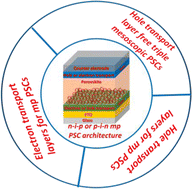
J. Mater. Chem. C, 2022,10, 11063-11104
https://doi.org/10.1039/D2TC00828A
Best practices in the measurement of circularly polarised photodetectors
Here we provide a framework of standardised apparatus and tests which enable rigorous characterisation of the performance of photodetectors sensitive to circular polarisation, enabling meaningful comparisons between devices reported in literature.

J. Mater. Chem. C, 2022,10, 10452-10463
https://doi.org/10.1039/D2TC01224C
Design of biodegradable and biocompatible conjugated polymers for bioelectronics
Blueprints for the chemical design of biodegradability and biocompatibility for organic semiconductors. Recent trends and future areas of interest are discussed.
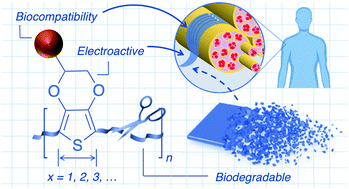
J. Mater. Chem. C, 2021,9, 13543-13556
https://doi.org/10.1039/D1TC03600A
Elucidating the electronic properties of single-wall carbon nanohorns
Thermopower measurements directly illustrate that as-grown SWCNHs are p-type semiconductors, while chemical doping can also be used to tune the majority carrier density and type.

J. Mater. Chem. C, 2022,10, 5783-5786
https://doi.org/10.1039/D2TC00179A
Modular chiral Eu(III) complexes for efficient circularly polarized OLEDs
Chiral lanthanide complexes can be prepared by choosing the achiral antenna ligand and the chiral inducer independently. With this modular approach, complexes optimized for use in efficient CP-OLEDs may be obtained.
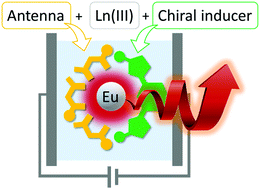
J. Mater. Chem. C, 2022,10, 463-468
https://doi.org/10.1039/D1TC05023K
Dithia[9]helicenes: Molecular design, surface imaging, and circularly polarized luminescence with enhanced dissymmetry factors
Synthesis of two dithia[9]helicenes by means of a LED-based double photocyclization is reported.
![Graphical abstract: Dithia[9]helicenes: Molecular design, surface imaging, and circularly polarized luminescence with enhanced dissymmetry factors](/en/Image/Get?imageInfo.ImageType=GA&imageInfo.ImageIdentifier.ManuscriptID=D2TC02910C&imageInfo.ImageIdentifier.Year=2022)
J. Mater. Chem. C, 2022,10, 14306-14318
https://doi.org/10.1039/D2TC02910C
Solution-processable donor–π–acceptor type thieno[3,2-b]thiophene derivatives; synthesis, photophysical properties and applications
Two new D–π–A-type fluorescent materials with nearly quantitative quantum yields, possessing thieno[3,2-b]thiophene, triphenylamine and boron units, were synthesized and their devices were fabricated via a solution process.
![Graphical abstract: Solution-processable donor–π–acceptor type thieno[3,2-b]thiophene derivatives; synthesis, photophysical properties and applications](/en/Image/Get?imageInfo.ImageType=GA&imageInfo.ImageIdentifier.ManuscriptID=D2TC02371G&imageInfo.ImageIdentifier.Year=2022)
J. Mater. Chem. C, 2022,10, 10719-10727
https://doi.org/10.1039/D2TC02371G
Enhancing hole carrier injection via low electrochemical doping on circularly polarized polymer light-emitting diodes
The noble electrochemical doping agent enables stable electrochemical doping of achiral π-CP in π-CP:aza[6]H blends, which allows better charge injection and balance for efficient circularly polarized optoelectronic devices.
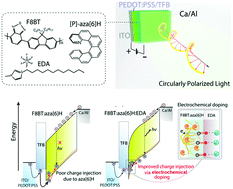
J. Mater. Chem. C, 2022,10, 9512-9520
https://doi.org/10.1039/D2TC01010K
Inverted organic photovoltaics with a solution-processed Mg-doped ZnO electron transport layer annealed at 150 °C
Mg acetate is added to Zn acetate solutions to form Mg-doped ZnO electron transport layers with an annealing temperature of 150 °C. Application of the Mg-doped ZnO in organic photovoltaic enhances the efficiency compared to devices with undoped ZnO.
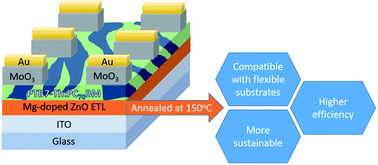
Sustainable Energy Fuels, 2022,6, 2835-2845
https://doi.org/10.1039/D1SE02001C
Understanding electrochemical properties of supported lipid bilayers interfaced with organic electronic devices
Native and synthetic membranes can be electrically monitored by creating supported lipid bilayers on top of conducting polymer electrodes. Cell membrane characteristics, e.g. the function of transmembrane proteins, are studied in this paper, along with device sensitivity.
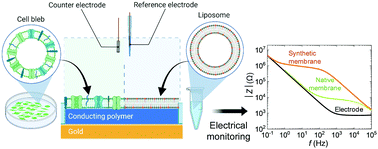
J. Mater. Chem. C, 2022,10, 8050-8060
https://doi.org/10.1039/D2TC00826B
Relationship between molecular properties and degradation mechanisms of organic solar cells based on bis-adducts of phenyl-C61 butyric acid methyl ester
Change of the side chain position of bis-PCBM can modulate the molecular parameters and further serve as a strategy to control the stability of organic solar cells.
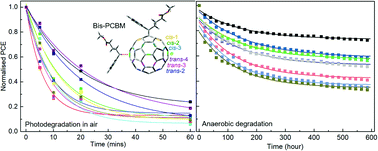
J. Mater. Chem. C, 2022,10, 7875-7885
https://doi.org/10.1039/D1TC05768E
Efficient bandgap widening in co-evaporated MAPbI3 perovskite
Co-evaporated perovskite solar cells have shown outstanding scalability, intrinsic stability, high efficiency and adaptability on rough surfaces. Here we present an optimal hybrid method to wide the co-evaporated MAPbI3's bandgap by a MABr treatment.
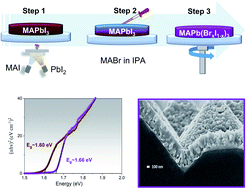
Sustainable Energy Fuels, 2022,6, 2428-2438
https://doi.org/10.1039/D1SE01692J
Engineering the sign of circularly polarized emission in achiral polymer – chiral small molecule blends as a function of blend ratio
We demonstrate CP-OLEDs with an impressive electroluminescence dissymmetry factor (gEL) > 0.3. The handedness of circularly polarized PL/EL can be inverted by varying the active layer thickness and chiral additive loading ratio.
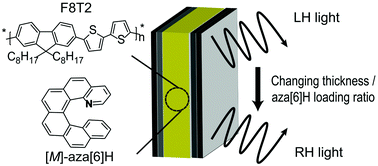
J. Mater. Chem. C, 2022,10, 5168-5172
https://doi.org/10.1039/D1TC05403A
Polariton condensation in a microcavity using a highly-stable molecular dye
We have fabricated organic polariton microcavities that exhibit remarkable photostability, even in the condensation regime.
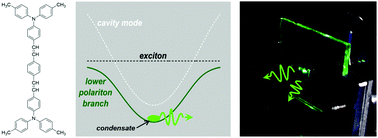
J. Mater. Chem. C, 2022,10, 4187-4195
https://doi.org/10.1039/D1TC05554B
Plasmonic PHOLEDs: increasing OLED stability
A novel organic light emitting device intentionally couples emitter energy to the plasmon mode for increased device stability and converts plasmons to photons to improve device efficiency.
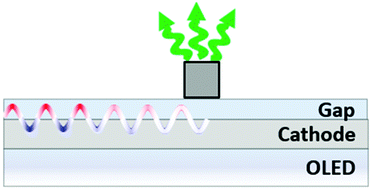
J. Mater. Chem. C, 2022,10, 4182-4186
https://doi.org/10.1039/D1TC05674C
Versatile methods for improving the mechanical properties of fullerene and non-fullerene bulk heterojunction layers to enable stretchable organic solar cells
A cross-linker and an elastomer are used to increase the mechanical compliance of the active layer in organic solar cells based on fullerene and non-fullerene acceptors without compromising their performance.
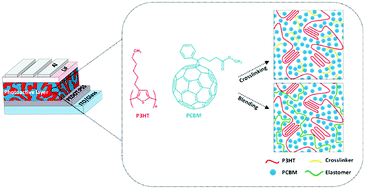
J. Mater. Chem. C, 2022,10, 3375-3386
https://doi.org/10.1039/D1TC05263B
Comparing the microstructure and photovoltaic performance of 3 perylene imide acceptors with similar energy levels but different packing tendencies
We have synthetized a series of perylene imide molecules with varying structure from planar to three-dimensional. The best photovoltaic performance is obtained when each acceptor is paired with a donor polymer with complementary packing tendency.
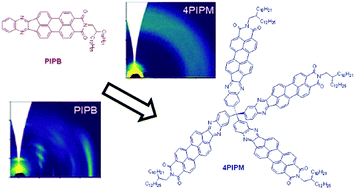
J. Mater. Chem. C, 2022,10, 1698-1710
https://doi.org/10.1039/D1TC05037K
Spiro donor–acceptor TADF emitters: naked TADF free from inhomogeneity caused by donor acceptor bridge bond disorder. Fast rISC and invariant photophysics in solid state hosts
The molecular photophysics of 10-phenyl-10H,10′H-spiro[acridine-9,9′-anthracen]-10′-one (ACRSA) are used as an ideal molecule to probe how external factors affect the TADF and rISC mechanisms.
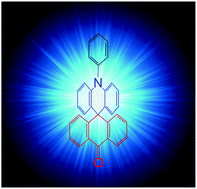
J. Mater. Chem. C, 2022,10, 1313-1325
https://doi.org/10.1039/D1TC04484B
Polymer source-gated transistors with low saturation voltage
High ionisation potential polymer transistors with unavoidable Schottky contacts are used to provide very stable and low-current operation with a very low saturation voltage of 2 V even with thick gate dielectric due to source-gated transistor design.
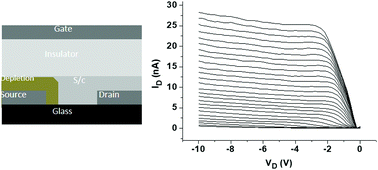
J. Mater. Chem. C, 2022,10, 1282-1288
https://doi.org/10.1039/D1TC05070B
The synthesis and application of novel benzodithiophene based reactive mesogens with negative wavelength dispersion birefringence
The factors influencing negative wavelength dispersion are investigated for a series of benzodithiophene based photopolymerisable liquid crystals.
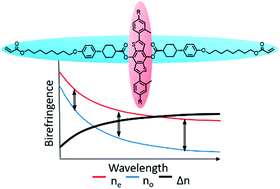
J. Mater. Chem. C, 2021,9, 17419-17426
https://doi.org/10.1039/D1TC05068K
In memoriam Alasdair James Campbell (11 May 1961–27 February 2021)
Celebrating the life of Alasdair Campbell.

J. Mater. Chem. C, 2021,9, 6100-6102
https://doi.org/10.1039/D1TC90083H
About this collection
As a physicist, Professor Al Campbell had a tremendous impact on the broad field of organic electronics, contributing fundamental research on state-of-the-art display technologies, printed solar cells, photodetectors and transistors, neuromorphic computing and organic biomedical sensors. His work influenced the fields of materials chemistry, bioelectronics and materials science by providing the mechanistic understanding and methods to exploit underlying solid-state physics phenomena.
Al’s fundamental understanding of structure-property relationships in organic, inorganic and hybrid semiconductors, coupled with his deep appreciation for electronics, allowed him to push new boundaries. Amongst these were the development of large-area printing technologies, resulting in flexible organic light-emitting diodes, organic field-effect transistors and polymer-based sensors for biochemical detection.
Ever on the quest for innovation, Al’s most recent research took him to the world of chiral functional materials, combining his knowledge of polyfluorenes with small chiral molecules to generate circularly polarised luminescence and absorption in OLEDs and photodetectors. Such devices have application in creating efficient displays, quantum optics, bioimaging and encrypted communications.
This collection of papers is a celebration of Al's achievements and contains papers from friends and colleagues in these areas, where he had such impact.